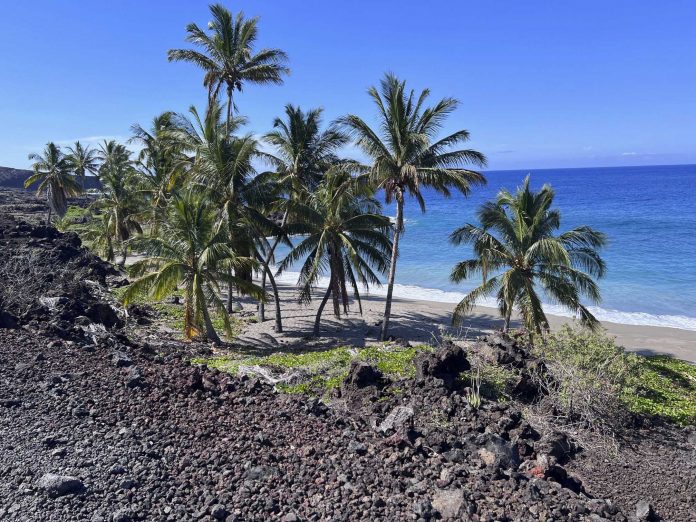
By CALEB JONES
Associated Press
HONOLULU (AP) — Hawaii Volcanoes National Park on the Big Island on Tuesday was given new land in a deal that will protect and manage a pristine white sand beach and ocean bay area that is home to endangered and endemic species and to rare, culturally significant Native Hawaiian artifacts.
Trust for Public Land, a national nonprofit land preservation group, transferred its ownership of Pohue Bay and surrounding land to the National Park Service.
Hawaii Volcanoes National Park has the world’s largest and most active volcanoes, Mauna Loa and Kilauea. Most of the coastline where the bay is located is made of ancient lava flows, black rock and sea cliffs that dart out into the ocean.
Pohue Bay, a rare and idyllic oasis in an otherwise rugged landscape, is home to endangered hawksbill sea turtles, green sea turtles, endangered Hawaiian monk seals and other species found only in Hawaii. The area houses anchialine ponds — landlocked pools with a mix of fresh and salt water — where rare Hawaiian red shrimp called ʻōpaeʻula live.
The area is also culturally significant because it has remains of ancient Hawaiian villages, petroglyphs, burial sites and the largest known abrader tool quarry in the state, according to the Trust for Public Lands. Abraders are ancient tools used for sanding, smoothing and grinding.
Park officials hope to eventually open the area up to the public, but the 26 square miles (67 square kilometers) of land will remain closed to visitors as national park staff consult with local experts and residents to better understand the various cultural sites.
The addition brings the total park size 554 square miles (1,425 square kilometers), almost as large as the entire island of Oahu.
While the park has recently acquired a few small parcels of land in the same area, the donation is the park’s largest addition since 2003, when about 156 square miles (404 square kilometers) of land was incorporated.
Hawaii Volcanoes National Park Superintendent Rhonda Loh in a statement called the Pohue Bay area “an incredibly precious and culturally significant landscape that needs to be protected.”
She added: “The park is working to develop an interim operating plan for Pohue that explores opportunities for public use compatible with resource protection.”
Trust for Public Land acquired the privately-owned land on Tuesday and gave it to Hawaii Volcanoes National Park the same day.
The parcel stretching from the southwest coast of Hawaii Island up to the national park was purchased for $9.4 million with funding from the Land and Water Conservation Fund and a donation from the Wyss Foundation. The land had previously been the target of several resort proposals, Trust for Public Land said.
“We are grateful the National Park Service will steward the area, ensuring the history, culture and natural beauty of this place are protected for future generations,” Trust for Public Land Associate Vice President Land Lea Hong, who leads the Hawaii division for the organization, in a statement.
















